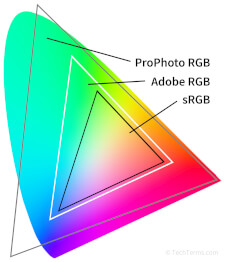Color Space
A color space is a specific range of colors a single image or monitor can display. Each color space covers a slice of the visible spectrum provided by a given color model. The boundaries of a particular color space, and the colors within those boundaries, are referred to as its gamut.
Color spaces can limit the colors used in an image to only those that a device is able to display, efficiently using the color spectrum to not waste information on out-of-gamut colors. The most common color space is sRGB, which is considered the bare minimum standard that any computer should be able to show. Higher-end monitors — like those used by photo and video professionals, or HDR-capable televisions — can display a wider gamut and use more advanced color spaces.
Most digital color spaces are based on the RGB color model, subdividing the available color spectrum into triangle-shaped slices. The larger the triangle, the wider the color gamut that color space can display. For example, the sRGB color space is comparatively small and can display fewer colors than bigger color spaces like Adobe RGB. Some other color spaces, like ProPhoto RGB, have such a large gamut that they can theoretically include colors outside the visible spectrum.
However, a wider gamut also means larger steps between colors. For example, if you save an image using the Adobe RGB color space with only 8 bits per channel, the colors may be more vibrant at their extremes than the smaller sRGB space, but with increased banding in gradient areas. By increasing the color depth to 10 or 12 bits per channel, you can include more variation within a color space.
 Test Your Knowledge
Test Your Knowledge